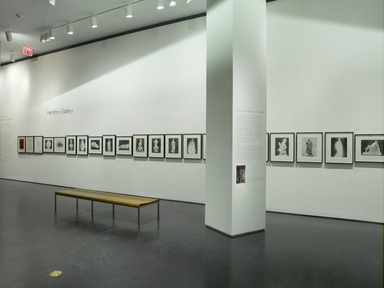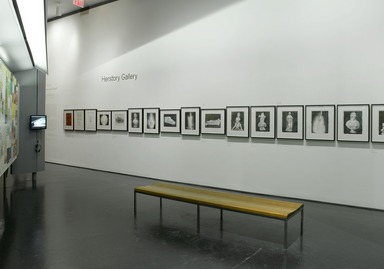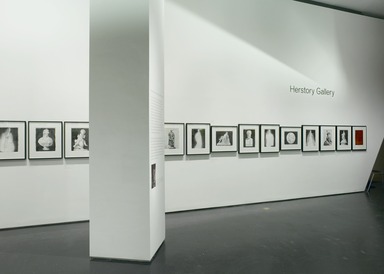

Patricia Cronin: "Harriet Hosmer, Lost and Found", June 05, 2009 through January 24, 2010 (Image: DIG_E2009_Patricia_Cronin_01_PS2.jpg Brooklyn Museum photograph, 2009)

Patricia Cronin: "Harriet Hosmer, Lost and Found", June 05, 2009 through January 24, 2010 (Image: DIG_E2009_Patricia_Cronin_02_PS2.jpg Brooklyn Museum photograph, 2009)

Patricia Cronin: "Harriet Hosmer, Lost and Found", June 05, 2009 through January 24, 2010 (Image: DIG_E2009_Patricia_Cronin_03_PS2.jpg Brooklyn Museum photograph, 2009)

Patricia Cronin: "Harriet Hosmer, Lost and Found", June 05, 2009 through January 24, 2010 (Image: DIG_E2009_Patricia_Cronin_04_PS2.jpg Brooklyn Museum photograph, 2009)
Patricia Cronin: "Harriet Hosmer, Lost and Found"
-
Patricia Cronin "Harriet Hosmer, Lost and Found"
This exhibition presents watercolors by the Brooklyn-based artist Patricia Cronin (American, b. 1963) that depict artworks by the nineteenth-century sculptor Harriet Hosmer (American, 1830–1908). Cronin discovered the work of Hosmer in 2002, through her research into Neoclassical sculpture. Although largely forgotten today, Hosmer was a sculptor who had achieved a remarkable level of success for a female artist in the nineteenth century.
Intrigued by this under-appreciated artist, Cronin embarked on the substantial undertaking of creating a catalogue raisonné (a publication that presents an artist’s complete artistic output) for Hosmer. Over five years, Cronin located most of Hosmer’s known work s, documented their current locations, and painted a watercolor of each. When Cronin found written references to sculptures that could not be located and had apparently never been photographed, she created what she calls a “ghost” watercolor, seven of which are on view here. The amorphous ghosts are placeholders for the lost works—an acknowledgment of their existence and a reflection of their mysterious status.
A selection of Cronin’s original watercolors is shown in this exhibition, and all are reproduced in the final publication, copies of which are displayed nearby in the Forum. Cronin’s Harriet Hosmer Catalogue Raisonné is both a scholarly tool with valuable reference material and an artist’s book that has hand-painted watercolors and interpretive “ghosts” in place of photographic reproductions. Its dual nature, both factual and imaginative, makes this publication unique.
In addition to being an act of reclamation, Cronin’s examination of Hosmer and her work is a conceptual exercise in which Cronin assumes the role of art historian, in keeping with a recent trend in which artists take on scholarly work that has traditionally been the domain of art critics and curators. At the same time, Cronin’s project is a haunting meditation on mortality, legacy, and remembrance.
Lauren Ross,
Interim Curator of the Elizabeth A. Sackler Center for Feminist Art -
Harriet Hosmer (American, 1830–1908)
At the height of her career in the 1850s and 1860s, the American expatriate sculptor Harriet Hosmer was running a successful studio in Rome and selling her work to distinguished collectors. She traveled in a circle of British and American artists and writers that included such luminaries as the poet Elizabeth Barrett Browning and writer Nathaniel Hawthorne, and she received numerous decorations from European royalty. She was a role model for women—an example of the type of success female artists could hope to achieve and an outspoken advocate for gender equality and suffrage. Despite all of this, Hosmer is mostly unknown today, and there is a dearth of significant scholarship on her work.
Hosmer’s is one of the 1,038 names that appear in The Dinner Party by Judy Chicago (installed nearby), an artwork that pays tribute to women throughout history, many of whose contributions have been overlooked. Hosmer’s name appears on the Heritage Floor near the place setting for the artist Georgia O’Keeffe, and her sculpture of Zenobia is reproduced on the Heritage Panels (in this gallery) under the place setting for Boadaceia.
-
March 1, 2009
A group of twenty-eight watercolors by Brooklyn-based conceptual artist Patricia Cronin, inspired by the work of nineteenth-century sculptor Harriet Hosmer (1830-1908), will be on view in the Herstory Gallery of the Elizabeth A. Sackler Center for Feminist Art at the Brooklyn Museum, June 5, 2009, through January 24, 2010. The Herstory Gallery is dedicated to exhibitions that elaborate on the 1,038 women who are named in Judy Chicago’s iconic feminist artwork The Dinner Party, installed in the adjacent space. Harriet Hosmer’s name appears on the Heritage Floor, near the place setting for Georgia O’Keeffe.
Cronin, who manipulates traditional art historical forms to address issues of sexuality, gender, and class, is the author of the forthcoming catalogue raisonné of the nineteenth-century sculptor, who defied social convention and attained a degree of notoriety for her often sensuous sculptures of women. In the catalogue raisonné, each of Hosmer’s works is illustrated by a Cronin watercolor, selections of which comprise the exhibition.
Harriet Hosmer’s works, created in the neoclassical style, depict historical, mythological, and literary figures, among them Zenobia, Medusa, and Puck. In her research for the catalogue raisonné, Patricia Cronin unearthed written references to several Hosmer sculptures that do not appear to have ever been photographed. To represent these works, Cronin has made watercolors of what she calls “ghosts,” formless and ethereal images of sculptures that in all likelihood still exist, but have been lost to art history, several of which are also included in the presentation.
The fact that Harriet Hosmer has been all but forgotten, save by art historians, formed the inspiration for Patricia Cronin’s investigation into her life and work and for writing the catalogue raisonné. Cronin views this project as not only the re-evaluation of the work of another artist, but as a meditation on her own fate in the future of art history.
Harriet Hosmer was born in Watertown, Massachusetts, and completed her education in Lenox, followed by study in anatomy at the St. Louis Medical College. Her first known work was a smaller version of Canova’s Napoleon, followed by a sculpture of an idealized head that was exhibited in Boston in 1852. That year she went to Rome with her father and her friend the actress Charlotte Cushman, where Hosmer studied with English sculptor John Gibson. She lived and worked in Italy for many years among other American expatriates, including George Eliot, George Sands, Robert and Elizabeth Barrett Browning, and Nathaniel Hawthorne, for whom she served as the model for Hilda in his The Marble Faun. Her reputation was established in the United States with the creation of a lively statue of Puck, which eventually sold dozens of replicas including one to the Prince of Wales, followed by numerous other sculptures, among them the reclining statue of Beatrice Cenci that was commissioned for the St. Louis Mercantile Library, as well as the monumental statue of Zenobia on which she worked for nearly two years.
Working in painting, sculpture, installation, and watercolor, Patricia Cronin’s critically acclaimed creations have been exhibited extensively, including solo exhibitions at the American Academy in Rome, as well as at Deitch Projects, White Columns, and Brent Sikkema Gallery in New York. She has been included in group exhibitions at such institutions as the Neuberger Museum, the Contemporary Art Center in Cincinnati, and the Tang Teaching Museum. Cronin is the recipient of awards from the Louis Comfort Tiffany Foundation, the New York Foundation for the Arts, and the Rome Prize, among others. She is Associate Professor of Art at Brooklyn College.
Patricia Cronin: Harriet Hosmer, Lost and Found has been organized by Lauren Ross, Interim Curator of the Elizabeth A. Sackler Center for Feminist Art.
Press Area of Website
View Original

